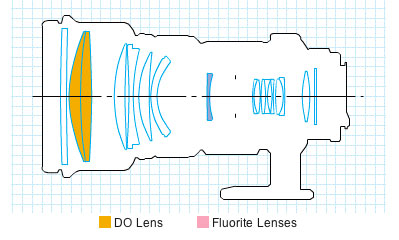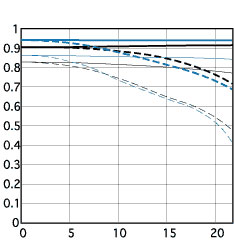
|
|||||||||||||||||||||||||||||||||||||||||||||||||||||||||||||||||||||||||||||||||||||||||||||||||||||||||||||||||||||||||||||||||||||||||||||||||||||||||||||||||||||||||||||||||||||||||||||||||||||||||||||||||||||||||||||||||||||||||||||||||||||||||||||||||||||||
| Focal Length & Maximum Aperture | 400mm 1.4 |
| Lens Construction | 17 elements in 13 groups |
| Diagonal Angle of View | 6° 10' |
| Focus Adjustment | Inner focusing system with USM |
| Closest Focusing Distance | 3.5m / 11.5 ft. |
| Filter Size | 52mm Drop-In |
| Max. Diameter x Length, Weight | 5.0" x 9.2", 4.3 lbs. / 128.0 x 232.7mm, 1940g |


|
A quick guide to MTF charts (which only measure contrast and resolution. Canon's guide to their MTF charts)
|
||
Which 400mm? - a list of all versions
| Canon EF 400mm | ||||||||
|---|---|---|---|---|---|---|---|---|
| Attribute | f/2.8 USM | f/2.8 II USM | f/2.8 IS USM | f/2.8 IS II USM | f/2.8 IS III USM | f/4 DO IS USM | f/5.6 USM | f/4 DO IS II USM |
| Key features | ||||||||
| Full-frame compatible | Yes | |||||||
| Image stabilizer | No | Yes | No | Yes | ||||
| Ultrasonic Motor | Yes | |||||||
| L-series | Yes | |||||||
| Diffractive Optics | No | Yes | No | Yes | ||||
| Technical data | ||||||||
| Aperture (max-min) | f/2.8-f/32 | f/4-f/32 | f/5.6-f/32 | f/4-f/32 | ||||
| Construction | 9 groups / 11 elements | 13 groups / 17 elements | 6 groups / 7 elements | 12 groups /18 elements | ||||
| Aperture blades | 8 | 9 | 8 | 9 | ||||
| Closest focusing distance | 4m | 3m | 2.7m | 2.5m | 3.5m | 3.3m | ||
| Max. magnification | 0.11x | 0.15x | 0.17x | 0.12x | 0.11x | 0.13x | ||
| Diagonal viewing angle | 6 ° | |||||||
| Physical data | ||||||||
| Weight | 13.44 lb / 6.1 kg | 13.03 lb / 5.91 kg | 11.83 lb / 5.37 kg | 8.48 lb / 3.85 kg | 6.26 lb / 2.84 kg | 4.27 lb / 1.94 kg | 2.8 lb / 1.25 kg | 2.1 kg |
| Maximum diameter | 6.57" / 167mm | 6.41" / 163mm | 5.03" / 128mm | 3.54" / 90mm/ | 5.04" /128mm | |||
| Length | 13.70" / 348mm | 13.74" / 349mm | 13.50" / 343mm | 9.16" / 232.7mm | 10.09" / 256.5mm | 9.16" / 232.7mm | ||
| Filter diameter | 48mm | 52mm drop-in filter | 77mm | 52mm drop-in | ||||
| Accessories | ||||||||
| Lens hood | ET-161B II | ET-155 | ET-155 (WII) | ET-155 (WIII) | ET-120 | Built-in | ET120 (WII) | |
| Case | 400 | 400C | 400E | 400B | 400D | |||
| Retail information | ||||||||
| Release date | April 1991 | March 1996 | Sept. 1999 | Aug. 2011 | Sept. 2018 | Dec. 2001 | May 1993 | Sept. 2014 |
EF 400mm f/4 DO IS USM reviews and articles
- Canon UK / US Information Page
- Amazon
- Northlight Images
- Canon CPN article
- Fred Miranda
- Lens Tip
- Digital Picture
- PhotoZone
- SLR Gear
- Lens Review
- ePhotozine
- Blog - Grant Atkinson
Sample images
None available.
Product launch
LAKE SUCCESS, N.Y. Sept. 6, 2000Canon U.S.A., the company whose imaging solutions give people Know How, today announced the development of the world's first "Multi-Layer Diffractive Optical Element'' for camera lenses.
A prototype Canon EF 400mm f/4 DO IS USM lens incorporating this element will be exhibited at Photokina 2000 in Cologne, Germany, from Sept. 20-25. A commercial version of this lens will be marketed during the first half of 2001.
Canon's history of advanced optical element development includes the creation of fluorite and aspherical elements, which have contributed to the realization of high-performance camera lenses. These optical elements are now found in a diverse range of lens products, such as interchangeable SLR camera lenses, and lenses for video camcorders and digital cameras. Canon's Multi-Layer Diffractive Optical Element, a major innovation in the world of optical technology, represents a milestone in that it possesses the characteristics of both fluorite and aspherical elements.
Diffractive optical elements have a diffraction grating that alters the path light travels through diffraction.(a) Such elements are already incorporated in such industrial instruments as spectroscopes and in signal-reading optical systems found in CD and DVD players. Diffractive optical elements, however, have not been employed in camera lenses due to the tendency of natural (white) light to produce superfluous diffracted light upon entering the lens, resulting in flare that degrades image quality.
Canon's Multi-Layer Diffractive Optical Element features a multi-layer construction comprising two single-layer diffractive optical elements with opposing concentric circular diffraction gratings. When incident light enters the Multi-Layer Diffractive Optical Element, superfluous diffracted light is not produced and almost all of the light is used for the image. The achievement makes possible for the first time the incorporation of a diffractive optical element in a camera lens.
The most significant characteristic of the diffractive optical element is that the positions where the wavelengths combine to form an image are reversed from those of a refractive optical element. By combining a Multi-Layer Diffractive Optical Element and a refractive optical element within the same optical system, chromatic aberration (color smearing), which adversely affects image quality, can be corrected even more effectively than with a fluorite element. Also, by adjusting the pitch (spacing) of the diffraction grating, the diffractive optical element makes possible the same optical characteristics as a ground and polished aspherical surface, which effectively corrects for spherical and other aberrations.
During the manufacture of the Multi-Layer Diffractive Optical Element's diffraction grating, the height and pitch of the diffraction grating as well as its positioning requires micron-level precision (1 micron equals 1/1000 mm). Such exacting accuracy was made possible through Canon's proprietary three-dimensional ultra-high-precision micro manufacturing technologies and the replicated aspherical lens manufacturing technology used in the production of Canon EF lenses. Such advanced technology also makes possible the manufacture of the ultra-precision diffractive optical element.
Canon will continue its research and development efforts with the aim of incorporating the Multi-Layer Diffractive Optical Element in a variety of products, such as interchangeable SLR camera lenses, digital camera lenses, HMDs (Head-Mounted Displays),(b) LCD projector lenses, and other imaging equipment.
| Used Canon Lenses • UK: MPB | Park • USA: B&H | Adorama |
 |
| Welcome to EFLens.com: The world's number 1 Canon Review website with every Canon EF Lens. Read all of the reviews, see detailed specifications and check the price. • EF Lens chronology • EF Lens date codes • EF Lens mount details • EF Lens filter sizes • Compare EF-S18-55 versions • Tweet about it • Tell a friend • Send feedback |
 |
| Canon Lens List: • EFLens.com |
 |
| Sigma Lens List: • Manufacturer's Website |
 |
| Samyang/Rokinon List: • Manufacturer's Website |
 |
| Tamron Lens List: • Manufacturer's Website |
 |
| Tokina Lens List: • Manufacturer's Website |
 |
| © 1987 - 2019 NI |
 Canon EF 400mm f/4 DO IS USM
Canon EF 400mm f/4 DO IS USM